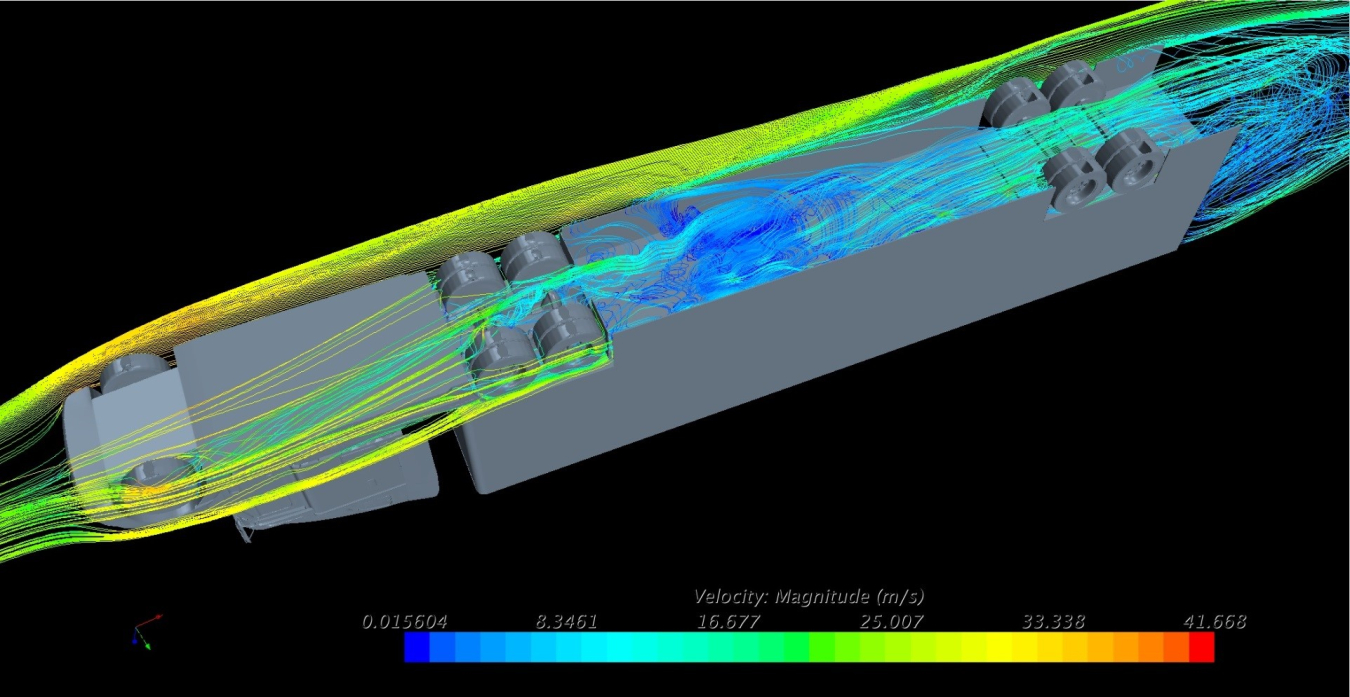
Tractor belly pan helps to improve under-body flow.
History of technology
Traveling down any U.S. highway, a driver is bound to see as many big rigs as they do other vehicles.
But in 10 years’ time, they could see a futuristic sleek, streamlined big rig that looks like something out of a sci-fi movie. Designing heavy-duty vehicles to be more aerodynamic is one major way to improve vehicle efficiency, and therefore, fuel economy. While heavy trucks currently use most of their propulsion energy to overcome drag and rolling resistance at highway speeds, technology available today can help substantially reduce this lost energy.
Addressing the challenge
Physicist Kambiz Salari at the Energy Department’s Lawrence Livermore National Laboratory (LLNL) is applying his expertise in fluid dynamics, computer modeling and simulation to improve the fuel economy of heavy vehicles through aerodynamic improvements. The program is funded by the Department of Energy’s Vehicle Technologies Office in the Office of Energy Efficiency and Renewable Energy.
Salari and his LLNL team, NASA Ames, and industry collaborators have already designed cost-effective aerodynamic add-on devices that help heavy vehicles on the road today achieve more than 15% fuel economy improvements. The devices, which are placed between the wheel wells, between the cab and the trailer, and behind the vehicle, were tested in the wind tunnel at NASA Ames. They also designed other non-aerodynamic technologies to improve efficiency, including more efficient wide-base single tires.
For the past decade, the LLNL team has published analysis that quantifies the incremental fuel savings benefits for a range of candidate aerodynamic add-on devices. This analysis has provided Class-8 commercial fleet managers with critical information to support technology adoption decisions. Based partly on this data, commercial fleets have rapidly invested in add-on fuel efficiency devices such as trailer skirts and box-tails because there is strong evidence that it will be good for their bottom line.
Partnering with industry
By partnering with multiple companies including Navistar, Freight Wing, ATDynamics, Kentucky Trailer, Wabash National, Frito-Lay, Spirit, Safeway, Michelin and Praxair, Salari and his team have significantly increased fleets’ adoption of aerodynamic and other energy-efficiency devices developed by LLNL.
According to a 2014 Fleet Fuel Efficiency Benchmark Study conducted by the North American Council for Freight Efficiency, the rate of customers and fleets accepting aerodynamic add-on devices has significantly increased since 2010. Fleets in the 2014 study included a number of major companies, including CR England, Con-way Truckload, Frito-Lay, Ryder, and United Parcel Service. The study examined the level of adoption of 66 technologies, which included several LLNL designs.
The study estimated trailer side skirt and tail devices used by long-haul truck fleets saved 1.1 billion gallons of diesel fuel annually.
Benefits
LLNL has continued to build on these successes with the development of an entirely new highly aerodynamic integrated tractor-trailer that could potentially make trucks have 30 percent better fuel economy when traveling at highway speeds. If adopted widely, this enhancement could translate into 10.2 billion gallons of diesel fuel saved per year and a reduction of 103 million tons of carbon dioxide emissions. LLNL projects these technologies could save fleets $25.5 billion per year, based on an average U.S. diesel fuel cost of $2.50.
